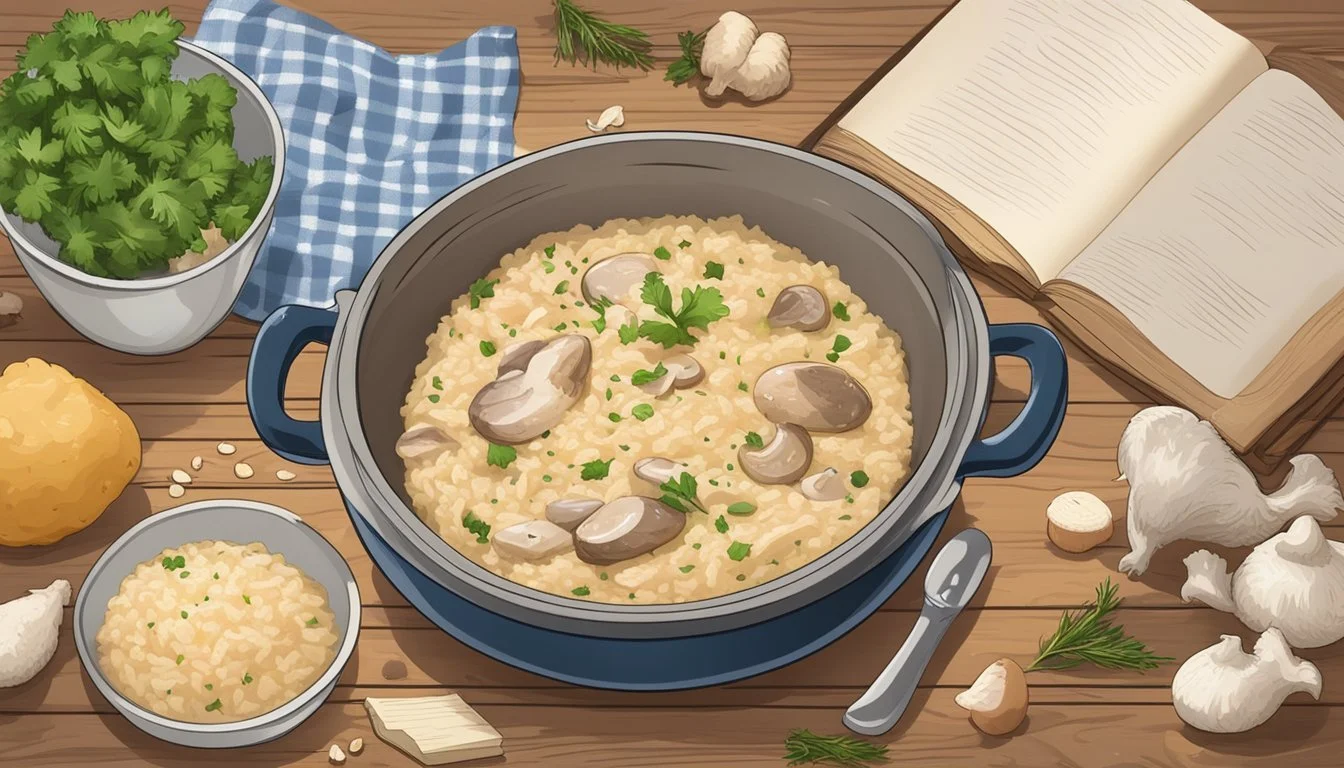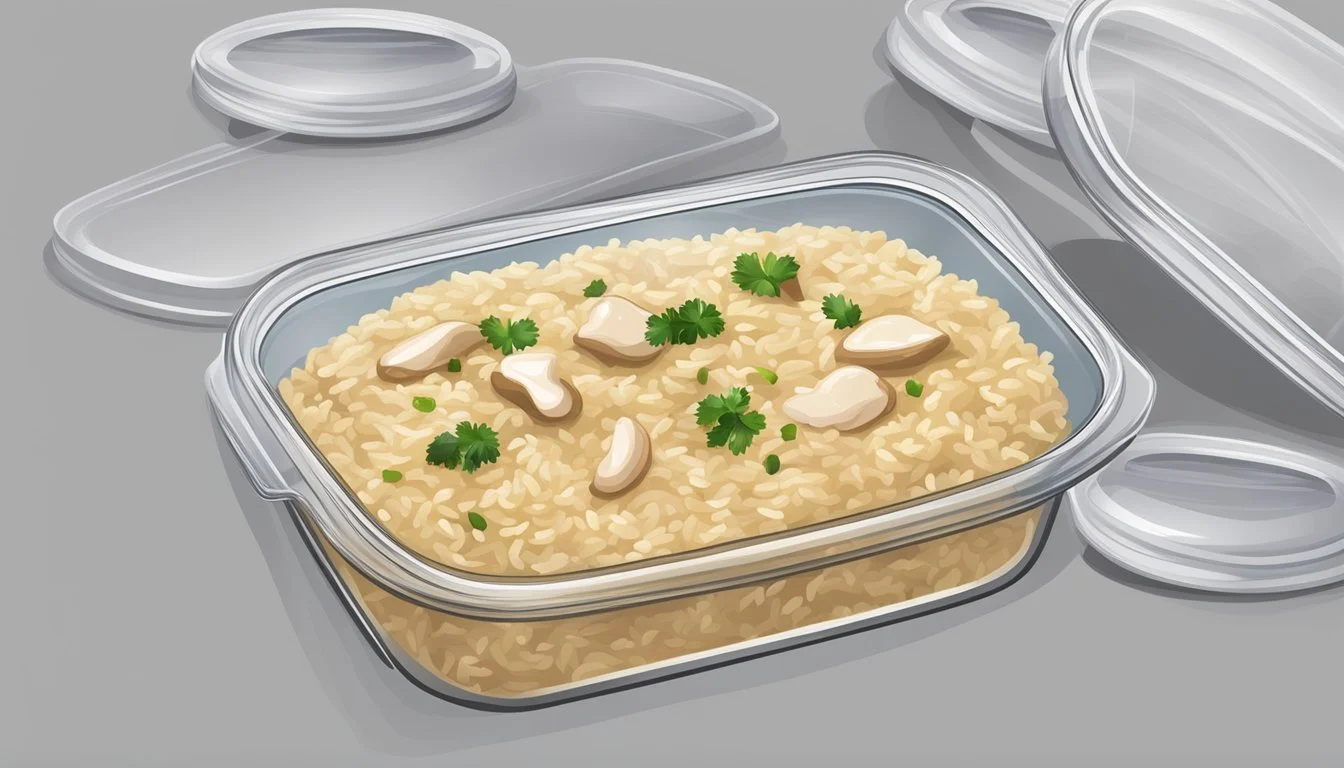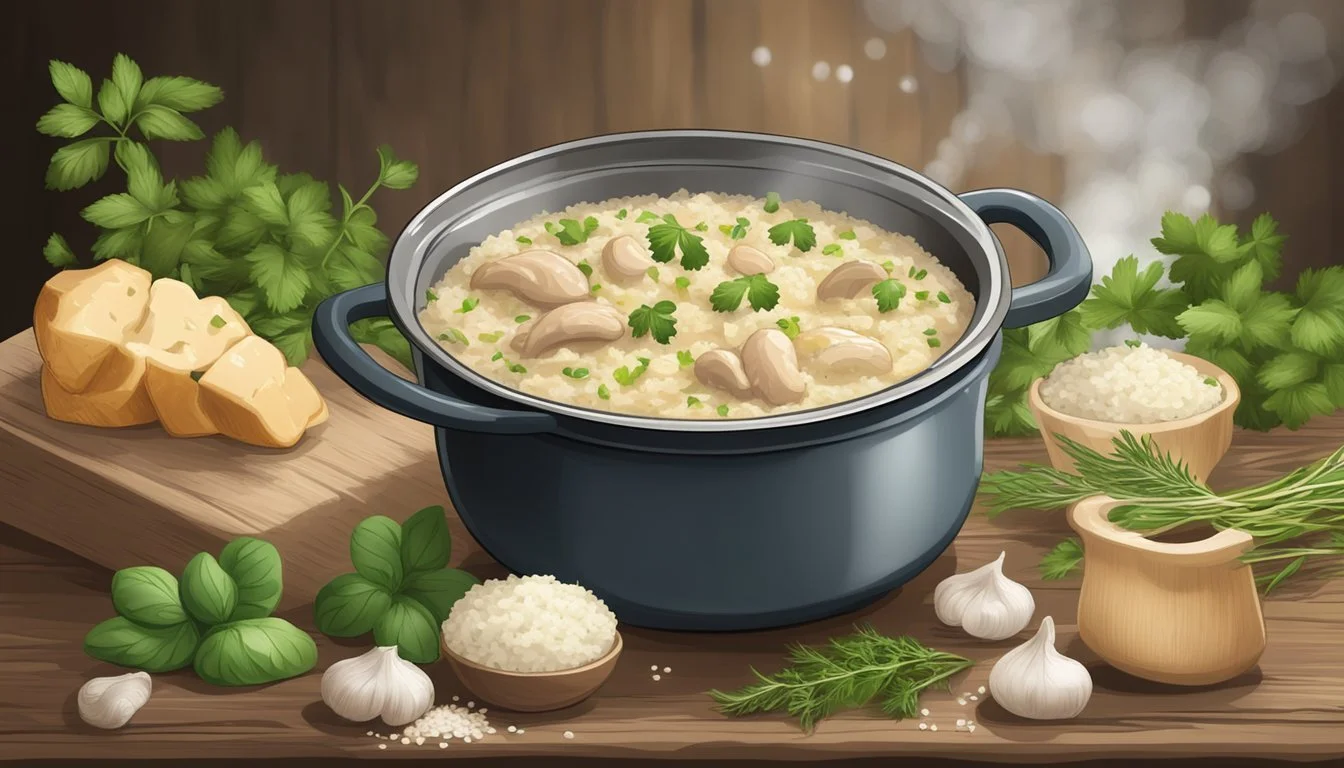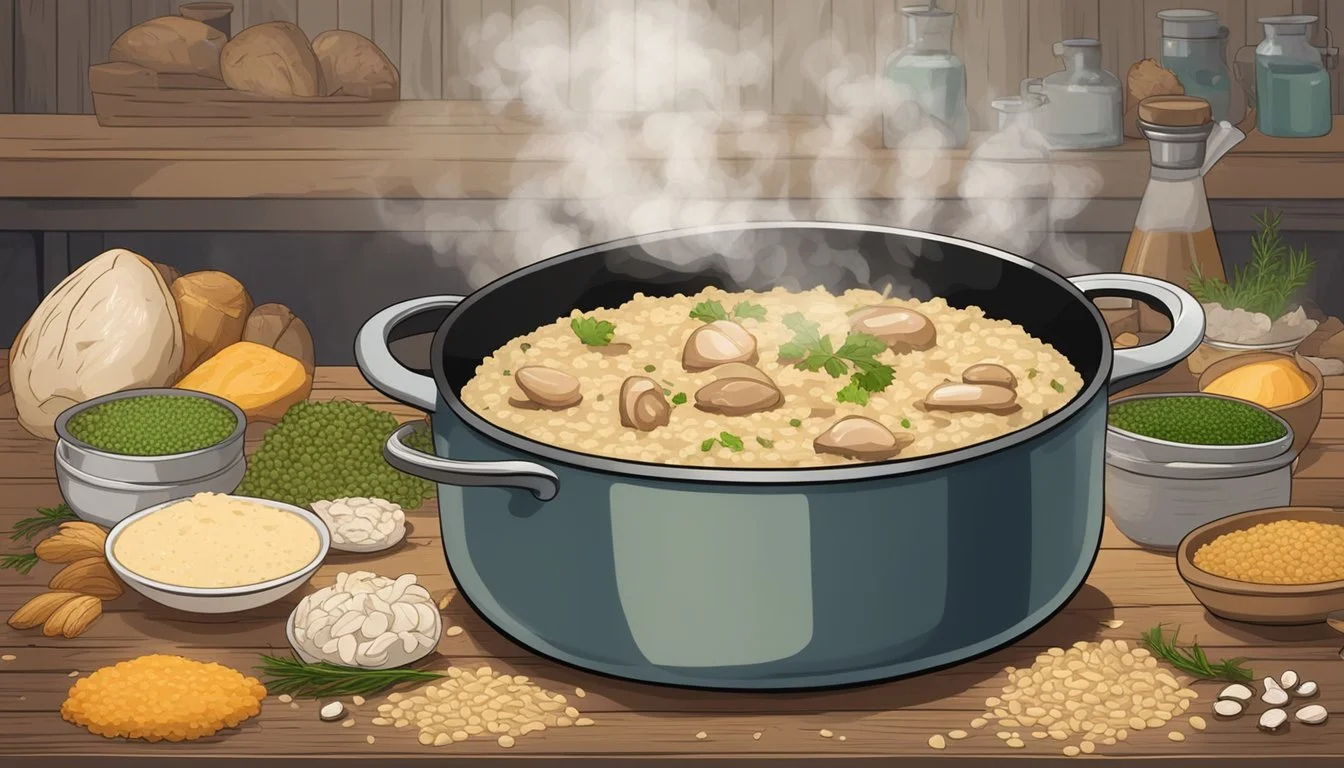How Long Does Chicken and Mushroom Risotto Last?
Expert Storage Tips
Preparing Chicken and Mushroom Risotto is not just about cooking; it's about enjoying a dish that's rich in flavor and texture. One common question home cooks ponder is how long their delightful risotto creation can last before it spoils. Chicken and Mushroom Risotto can typically be stored in the refrigerator for up to three to four days.
When properly stored in an airtight container, the flavors of the rice, chicken, and mushrooms meld wonderfully, making leftovers just as enjoyable as the fresh dish. Ensuring that the risotto is cooled quickly and kept at a consistent, cold temperature is key to maintaining its quality and safety.
Knowing the shelf life of your Chicken and Mushroom Risotto helps you plan meals efficiently, minimizing waste while maximizing enjoyment. Whether made with low-sodium broth, as some recipes suggest, or the traditional method, a well-stored risotto can make for a convenient and delicious meal option throughout the week.
Understanding Risotto
Risotto is a classic Italian dish known for its creamy texture and rich flavors. It requires careful preparation and the right ingredients to achieve the perfect consistency.
Key Risotto Ingredients
Arborio Rice: At the heart of any risotto is Arborio rice. This short-grain rice is high in starch, which is essential for achieving a creamy texture. The rice absorbs liquids slowly, allowing flavors to develop fully.
Stock: A good-quality stock is crucial. Whether it's chicken, vegetable, or mushroom stock, it should be flavorful. The stock is added gradually during cooking, which helps to release the rice's starch, contributing to the dish's creaminess.
Butter and Parmesan: These ingredients add richness and depth. The butter is typically stirred in at the end, enhancing the dish's silky texture, while Parmesan cheese provides a nutty, savory flavor.
The Art of Cooking Risotto
Constant Stirring: Stirring is essential in risotto preparation. It helps the rice release its starch, contributing to the creamy texture. The dish should be stirred almost constantly, ensuring the rice doesn't stick to the bottom of the pot.
Gradual Addition of Stock: Adding stock a little at a time allows the rice to slowly absorb it, ensuring even cooking. This gradual addition also helps the rice swell and release starch, creating a creamy base.
Cooking Time: Typically, risotto takes about 18-20 minutes to cook. The rice should be al dente, meaning it is firm to the bite but not hard. Overcooking can make the rice mushy.
Finishing Touches: The dish is often finished with a knob of butter and a generous handful of Parmesan cheese, stirred in to enhance the creaminess. Fresh herbs or a splash of white wine can be added for extra flavor.
Proper Storage Techniques
Storing chicken and mushroom risotto properly ensures that it remains safe to eat and retains its flavor and texture. Key methods include refrigerating for short-term storage and freezing for longer preservation.
Refrigerating Risotto
To store risotto in the refrigerator, let it cool to room temperature before transferring it to an airtight container. Keeping it in an airtight container prevents moisture loss and contamination. Place the container in the fridge at a temperature of 40°F (4°C) or below.
Labeled containers help track the storage time. Leftover risotto remains at its best quality for about 3-4 days in the refrigerator. If the risotto shows any signs of spoilage, such as an off smell or unusual texture, it is best to discard it.
Freezing Risotto
For long-term storage, freezing risotto is effective. Allow the risotto to cool completely before transferring it to a freezer-safe airtight container or a heavy-duty freezer bag. This step prevents freezer burn and ice crystal formation. Label the containers with the date they were frozen.
Frozen risotto maintains its quality for about 2-3 months. When ready to use, defrost in the fridge overnight or use a microwave's defrost function. Proper thawing methods help maintain the dish’s texture and flavor.
Safety and Shelf Life Considerations
Chicken and mushroom risotto requires careful handling and storage to ensure its safety and longevity. Key considerations include detecting spoilage and understanding potential foodborne illnesses.
Detecting Spoilage in Risotto
Detecting spoilage in chicken and mushroom risotto involves observing changes in texture, smell, and appearance. Spoiled risotto may develop a sour or unpleasant odor. The rice can become mushy or overly dry, indicating bacterial growth or dehydration. Visible mold or an unusual color also suggest spoilage.
To ensure food safety, always store risotto in an airtight container. Label the container with the date it was made. Risotto should be consumed within 3-4 days when refrigerated at 40°F (4°C) or lower.
Foodborne Illnesses Related to Risotto
Risotto, particularly when containing chicken, can be susceptible to foodborne illnesses caused by bacteria such as Bacillus Cereus, Salmonella, and Listeria. These bacteria can thrive in improperly stored risotto. Bacillus cereus can survive cooking and produce toxins if rice is left at room temperature too long.
To minimize risks, promptly refrigerate risotto within 2 hours of cooking. Reheat leftovers to an internal temperature of 165°F (74°C) to kill any lingering bacteria. Risk of contamination increases if risotto is not stored correctly or kept for too long. Freezing risotto can extend its shelf life, but beware of freezer burn affecting quality.
Reheating Stored Risotto
To retain the creamy texture of your chicken and mushroom risotto, it's crucial to use methods that add moisture and even heating. Below are effective ways to reheat your risotto: in the microwave, on the stovetop, and in the oven.
Microwave Method
Reheating risotto in the microwave is quick and convenient.
Place the risotto in a microwave-safe dish.
Add 1-2 tablespoons of chicken or vegetable broth to maintain moisture.
Cover the dish loosely with a lid, damp paper towel, or microwave-safe plastic wrap to prevent mess.
Heat on medium-high power in 30-second intervals, stirring between each interval.
Continue until the risotto is heated through, ensuring it retains its creamy texture.
Stovetop Approach
Using the stovetop method, you can closely control the heat and moisture level.
Place the risotto in a non-stick skillet.
Add 1/4 cup of chicken or vegetable broth per cup of risotto.
Heat on medium-low, stirring frequently to avoid sticking.
Keep adding small amounts of broth if the risotto begins to dry out.
Cook until the risotto is heated through and reaches the desired creaminess.
Oven Reheating Technique
Reheating risotto in the oven ensures even heating, though it takes more time.
Preheat the oven to 350°F (175°C).
Place the risotto in an oven-safe dish.
Add 1/4 cup of broth or water per cup of risotto to maintain moisture.
Cover the dish with foil to trap steam and maintain a creamy texture.
Bake for 15-20 minutes, stirring halfway through, until the risotto is heated evenly.
Different methods suit various preferences and situations. Ensure to adjust liquids as needed to retain the risotto's creamy consistency.
Maximizing the Flavor and Quality
To ensure chicken and mushroom risotto remains delicious and maintains its desired texture, consider specific steps during reheating and storage. Here’s how to enhance flavors and keep the risotto creamy.
Enhancing Flavor After Reheating
When reheating chicken and mushroom risotto, gradually warming on the stove can help retain its flavor. Using a splash of chicken broth or water can inject moisture back into the dish.
Adding freshly grated Parmesan cheese boosts richness and flavor. Incorporate butter and finish with freshly ground black pepper to enhance taste.
Avoid microwave reheating if possible, as it may lead to uneven heating and compromise taste.
Maintaining Creaminess
To keep risotto creamy, add a small amount of warm liquid, such as broth, during reheating. Frequently stir the risotto to ensure a smooth consistency.
Incorporate extra butter and Parmesan cheese while warming to maintain its creaminess. Using oil can help keep the risotto from drying out.
Serve immediately after reheating to enjoy the optimal texture and creaminess.
By following these steps, you can ensure your chicken and mushroom risotto remains flavorful and creamy even after storage and reheating.
Alternative Grains and Risotto Types
Cooking risotto doesn't have to be limited to Arborio rice. Many different grains can achieve a creamy, delicious risotto-like texture while providing unique flavors and nutritional benefits.
Non-Arborio Rice Risottos
While Arborio rice is the traditional choice, Carnaroli rice is an excellent alternative. Known for its higher starch content, Carnaroli yields an even creamier texture.
Calrose rice, a medium-grain variety, also makes a suitable substitute. It's commonly used in American kitchens and provides a similar creaminess to Arborio when cooked properly.
Other options include Basmati and Jasmine rice. These varieties can add distinctive flavors to your dish while still delivering a satisfying texture. Though they may not be as creamy, they offer unique aromatic qualities.
Legume and Grain Substitutions
Barley and Farro are popular alternatives for a heartier risotto. Barley risotto provides a chewy texture and is rich in fiber.
Lentils can also be used, offering a high protein content and a different texture altogether. While they don’t become creamy like traditional risotto rice, lentils add nutritional value and density to the dish.
For a low-carb alternative, consider cauliflower risotto. Finely chopped cauliflower bits mimic the size and texture of rice. It cooks faster and offers a lighter, vegetable-forward option that still has a creamy consistency when prepared correctly.








